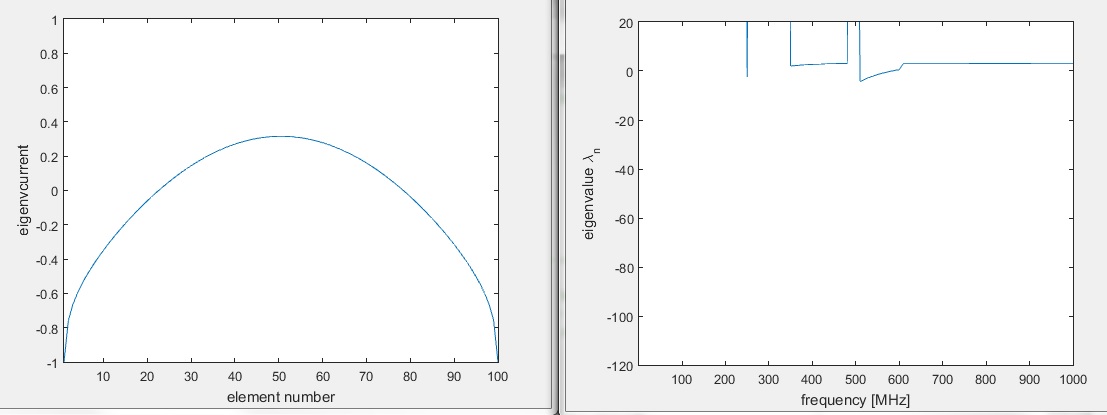Characteristic Mode Theory Matlab
I would like to implement a simple characteristic mode analysis for a dipole antenna in Matlab. I would like to ask for some help with matlab implementation. getting the impedance matrix Z using MoM and finding its characteristic modes
This is the result I get

can you share the code or information related to this?
There are several places online to get these codes. I assume you are using the method of moments? You can get Balanis codes online, but I don't recall where. I am sure a google search will turn them up. I also know there are several codes on the Mathworks website for this. Here is another, and even more powerful, code:
http://ece.wpi.edu/books/aemm/
Hope this helps!
Thanks. I developed my own code for the generation of impedance matrix. (Soon I will share the code). May I know, How you performed the mode tracking?
The data I have is eigen values and eigen vector. Now I have to perform mode tracking and surface current visualization. any suggestion?
Thanks
What do you mean by mode tracking? This is not an electromagnetic problem I have worked on that much, but I did not solve it as an eigen-value problem. I solved it as a scattering problem. The main difference is that my simulations needed a source. I based some of my codes on Pocklinton's integral equation and others on Harrington's integral equations. I played both with gap sources and frill sources. If I were learning this method for the first time, I would go with a gap source and Pocklington's integral equation as that is the easiest approach. I did not see as large of a convergence difference as I was led to believe from the literature.
When solving this as a scattering problem, your final matrix equation is
[Z][i] = [v]
where [Z] is the impedance matrix, [i] are the unknown currents in your elements, and [v] are the voltages applied to each element. A simple gap source as [v] as all zeros except at the point of the feed where you set it to 1.
You solve the matrix equation as
[i] = [Z]\[v]
If you plot [i] after obtaining the solution you will see the current distribution.
Dear Sir,
I am sorry (it looks like I am showing light to SUN), but the characteristics mode analysis is the source free analysis. Instead of more text , I am sharing the paper which I am following. In that paper, figure 3 tells basic idea about the CMA.
Miloslav Capek, Pavel Hamouz, Pavel Hazdra, and Jan Eichler, "Implementation of the Theory of Characteristic Modes in MATLAB" IEEE Antennas and Propagation Magazine, Vol. 55, No. 2, April 2013
Looking froward for your generous response.
(BTW, I followed you tutorials (and lectures), and they are great. Thank you for such a nice lectures on CEM)
"showing light to the SUN" That's funny. Thank you, but I am glad to help.
I scanned the paper quickly and saw some MATLAB code. Is not all of the code in this paper?
Assuming no, there is a great book and website on this exact topic of MoM for 3D antennas based on RWG edge elements. In fact, I have a link to it from my website. The website does not have the best explanation of the theory, but it provides all the codes and a very good explanation about how use them. It does not talk about characteristic mode analysis that I recall (it has been a while), but it will give you the impedance matrix from which you can do your characteristic mode analysis. Here is the link:
http://ece.wpi.edu/mom/
I am confident this is what you need. BTW, here is a link to my research website that may have more things of interest to you...
http://emlab.utep.edu/
Good luck! Hope this helps!
Dear Sir,
Thank you for your response. Can you share me the cpp code (given in the documentation, but only the compiled DLL file is included). Because I need to modify the code according to my requirement.
Thank you
They are MATLAB codes, but you have to dig a little deeper on the website. Here is a lower level link:
http://ece.wpi.edu/books/aemm/
From here, click on 'Scripts' at the upper left. Then click on 'Here' and then the chapter number. There should not be anything other than MATLAB files that you need.
Characteristic Mode Matlab 相关文章:
